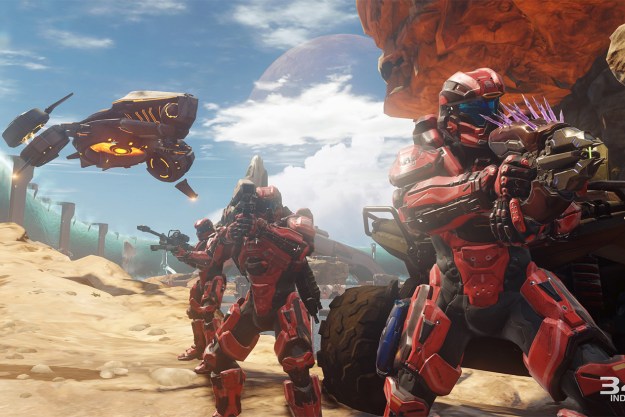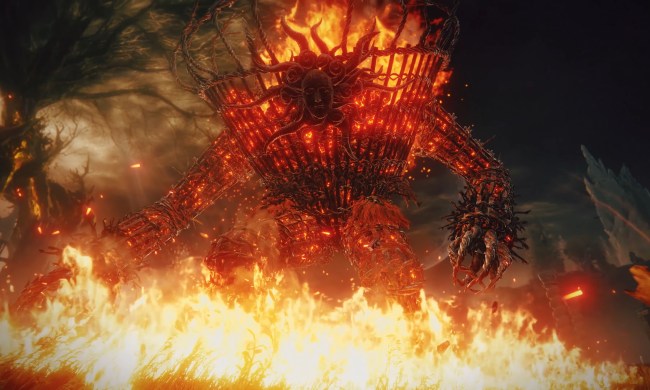
“Halo 5: Guardians is great if you’re a big fan of its multiplayer modes, but its campaign is the weakest of the series.”
- Huge new multiplayer battles in Warzone
- Smart new REQ system
- Campaign mode encourages playing with friends
- Utterly inconsequential story
- Campaign is a slog when playing alone
Halo 5: Guardians, according to its marketing, is the biggest evolution the series has ever seen. The largest demonstrable change, however, is in making the game — and by extension, the series — fully focused on its multiplayer components.
While it is possible to play Halo 5 alone — the single-player campaign will last most people about eight hours — it’s much harder to enjoy alone. This is a game that has been built to play with friends, and when fired up solo, is more often a tough, annoying slog full of repetitive battles. For those fans who are in it for Halo’s big-budget campaigns set across sprawling, distant planets, you’re going to want to bring (or make) some friends in order to get the most out of the experience.
Only for the Die-Hards
Halo has always been a cooperative affair with a deep competitive multiplayer mode, and those things are preserved in Halo 5, more or less at the expense of anything else. For the first time, the series adds four-player co-op, allowing you to take on its story missions with three friends. Having at least one buddy along is, in many ways, absolutely essential. Halo 5 doesn’t just support co-op: it barely works without it.
Warzone is a huge, chaotic mashup of everything Halo 5 has to offer in one massive, exciting battle.
The game picks up some time after the events of Halo 4, following simultaneously the stories of series protagonist Master Chief, the Spartan super soldier responsible for saving humanity on more than one occasion, and a second group of Spartans on his trail. When Master Chief goes off-mission early in the game with three squad mates in pursuit of Cortana, the series’ long-running artificial intelligence companion who (spoiler alert) seemingly “died” at the end of Halo 4, the second group, Fireteam Osiris, is dispatched to rein him in. The vast majority of the game is spent with this new team as they follow in Chief’s footsteps, trying to figure out what is going on in the galaxy.
What exactly is going on is somewhat opaque. Halo is a series with rich lore but which hasn’t always been good at telling in-game stories, and that’s never been truer than in Halo 5. The story spends the lion’s share of its running time — 12 of its 15 missions — following Osiris as it tries to piece together what’s going on with Chief. Glimmers of plot, like the fact that Cortana is summoning giant ancient robots to her from various planets for reasons unknown, and that these robots are apparently causing the destruction of human colonies along the way, are doled out in short, confused bits.
As a story, Halo 5 is all setup and no payoff. It’s clear that the real tale is being told in the inevitable Halo 6, and nothing of substance happens in the interim.
That Halo 5 spends so much of its time with Osiris suggests the real purpose of the game is to launch a spinoff franchise starring the new group, but every storytelling ball is dropped along the way. Halo 5’s marketing suggests an emotional conflict between the questionably-loyal Chief and the “traitor-hunting” Osiris leader, Locke, but those moments are barely in the game.
Worse is that developer 343 Industries is serving a certain brand of Halo fan to the exclusion of all others. To understand Halo 5’s stories, one needs to be deeply embroiled in 343’s transmedia push. That means being caught up on previous games, two live-action short series, numerous side novels, the “Hunt the Truth” podcast, and probably more. It all comes off as a confusing mess for people who haven’t been highly dedicated Halo junkies for years.
The Benefits of Friends
The campaign mode, then, isn’t worth addressing for the story, but it can be fun with a friend or three. Unlike earlier Halo games, all of Halo 5 is played with a squad of three teammates backing players up, and each of those characters can be inhabited by a human player. When alone, those characters are controlled by the game’s artificial intelligence, capable of responding to a few simple orders (target that enemy, move to that location, jump into that vehicle) and of reviving one another and the player if they take too much damage and fall in battle.
The squad AI is undeniably stupid, easily confused and generally useless.
The AI, however, is undeniably stupid, easily confused and generally useless. Often it fails to fire on enemies at all without a direct order, or shoots so sporadically as to be no help. It gets confused by level layout, struggles to make its way to players who need reviving before their timer runs out and they die for good, and is terrible at keeping itself alive. Playing alone, the AI squad is an anchor around the player’s neck, specifically when trying to take on harder difficulty levels.
It’s clear Halo 5 has been heavily weighted around playing with other people, and with friends in the game, it’s easy to see how 343 has carefully designed almost every enemy encounter to include lots of potential variation and tactical planning. Little changes to the game, like the ability to sprint and smash through certain walls or climb ledges, allow players to coordinate as they split up and take on different tactical roles. Plenty of tougher enemies have weak points on their sides or backs that are clearly specifically designed so that players work together to flank and take them down. Played with a friend, the campaign can be a lot of fun, requiring smart teamwork all the way through.

Try to do that with the AI squad by your side, however, and you’ll be met with mostly with frustration. Particularly late in the game, there are many bigger, more difficult battles that will test players’ skills, and the AI squad can’t be relied upon to execute even basic tactics. Blast open a side path and start sniping, for example, and you might turn around to find the rest of your squad has followed you and is standing idly a few feet away, out of the fight. At one point during a mission I played cooperatively with a friend, the AI teammates stayed in the area’s elevator, ignoring combat altogether. The AI system is badly broken, and it drags down the campaign experience at every step.
Add to the mix that 343 has opted to allow only online cooperative play and things become even more irritating. Halo has long enjoyed local split-screen “couch” co-op, and to build a game that’s so obviously meant to be played with others — and then take away the easiest and most enjoyable way of jumping into the game with a friend — seems like a huge and glaring oversight at best, and a downright stupid decision at worse.
A Boost Forward in Competition
What most players likely want out of Halo 5 is competitive multiplayer, and it’s in that mode the game largely makes up for its many missteps in the campaign mode. The more standard multiplayer matches, like team deathmatch or capture the flag, are now found under the heading “Arena,” and these benefit greatly from the changes in movement mechanics that make the cooperative campaign work.
Meanwhile, in the new “Warzone” mode, multiplayer expands into a much bigger, more involved affair. Warzone matches are of two types, each sporting 12-player teams: a “capture/defend” style mode in which one team attacks a series of objectives while the other team defends them; and a mode that mixes both AI enemies and an opposing team to create a hybrid game type. It’s this second version that is the most interesting iteration of the idea, because it includes plenty of different focuses that allow even lower-skilled players to contribute meaningfully to victory.
In these Warzone fights, players not only work to kill opposing teammates, they also try to capture locations by clearing them of resistance, both human- and computer-controlled. Players are earning points for their team by killing other players, capturing locations, and defeating AI-controlled bosses, and it requires a combination of efforts — and a lot of team coordination — to win a match.
Augmenting all this is the new “REQ” system, by which players earn points to buy REQ packages, which dispense random “cards.” These cards represent everything from guns and vehicles to damage and shield boosters. As a team earns more points, they increase their overall “REQ” level, allowing players to use the cards they’ve unlocked to summon stronger guns, bigger vehicles, or additional bonuses to the battle. Warzone quickly becomes a huge, chaotic mashup of everything Halo 5 has to offer in one massive battle, where you can destroy a tank one moment, team up with your teammates and fight a boss the next, and then move on to flank the enemy squad and capture one of their bases after that. It’s a great way to utilize all of Halo’s varied offerings in one big match.
The REQ system adds a lot of variety to matches, and the advantages they offer are generally offset by the size of the match, so it doesn’t turn into a story of “the team with the best cards wins.” There’s always something else to do, someone else to fight, and somewhere else to go.
Conclusion
Halo 5 might be an evolution for the series, but it’s not a wholly positive one. The campaign feels like a painful misfire, despite being populated with fairly interesting characters and many a gorgeous locale. The game’s hindered by the areas where it’s clear the least work was added, like squad AI, and without some friends or some serious Halo fan cred, there’s little reason to bother with the campaign at all.
The DT Accessory Pack
Up your game and the get the most out of your gear with the following extras, hand-picked by our editors:
Halo 5: Guardians Limited Edition Xbox One controller ($70)
Xbox One Elite controller ($150)
Turtle Beach Earforce Xbox One headset ($80)
Multiplayer, on the other hand, feels like a strong step forward for the franchise. The Arena mode benefits greatly from changes in Halo movement mechanics to become fast-paced, vertical, and intense, and Warzone effectively mixes all the big pieces of the Halo experience into one giant, exciting battle.
Misgivings creep in, however. I was plagued by strange connectivity issues during the pre-launch test sessions set up by 343 that seem more related to bugs than issues with Internet speed. The REQ system, interesting though it is, also comes with built-in microtransactions that weren’t in the review build of the game and thus were impossible to judge. Given how useful REQs can be in Warzone, though, it seems reasonable the system could stray into the dreaded wasteland of “pay to win.”
Halo 5 feels like a side story in the franchise, laying foundations for other efforts in 343’s growing transmedia effort than actually trying to take the franchise forward. It’s a fun, exciting experience under the right circumstances. Unfortunately, without those prerequisites being fulfilled — namely, having other people with copies of the game handy — it undercuts many of the things Halo fans have come to expect from the series.
Updated on 10-27-2015 by DT Staff: Microtransactions in the Warzone REQ system, which were not present in the review build, have been noted.
Highs
- Huge new multiplayer battles in Warzone
- Smart new REQ system
- Campaign mode encourages playing with friends
Lows
- Utterly inconsequential story
- Campaign is a slog when playing alone
Available at: Amazon Best Buy Target Gamestop









